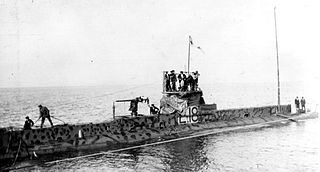
The Russian Navy is the naval arm of the Russian Armed Forces. It has existed in various forms since 1696; its present iteration was formed in January 1992 when it succeeded the Navy of the Commonwealth of Independent States.

Kronstadt is a Russian port city in Kronshtadtsky District of the federal city of Saint Petersburg, located on Kotlin Island, 30 km (19 mi) west of Saint Petersburg, near the head of the Gulf of Finland. It is linked to the former Russian capital by a combination levee-causeway-seagate, the St Petersburg Dam, part of the city's flood defences, which also acts as road access to Kotlin island from the mainland.

The Soviet Navy was the naval warfare uniform service branch of the Soviet Armed Forces. Often referred to as the Red Fleet, the Soviet Navy made up a large part of the Soviet Union's strategic planning in the event of a conflict with the opposing superpower, the United States, during the Cold War (1945–1991). The Soviet Navy played a large role during the Cold War, either confronting the North Atlantic Treaty Organization in western Europe or power projection to maintain its sphere of influence in eastern Europe.

The Baltic Fleet is the fleet of the Russian Navy in the Baltic Sea.

A British submarine flotilla operated in the Baltic Sea for three years during the First World War. The squadron of nine submarines was attached to the Russian Baltic Fleet. The main task of the flotilla was to prevent the import of iron ore from Sweden to Imperial Germany. The success of the flotilla also forced the German Navy in the Baltic to keep to their bases and denied the German High Seas Fleet a training ground. The flotilla was based in Reval (Tallinn), and for most of its career commanded by Captain Francis Cromie.

The Peter the Great Naval Corps - Saint Petersburg Naval Institute, formerly known as the M. V. Frunze Higher Naval School, is the oldest of the Russian Navy's naval officer commissioning schools. It is located in Saint Petersburg.

B-585 Sankt Peterburg is the lead boat of the Lada-class submarines of the Russian Navy. The Lada class is the fourth generation of diesel-electric submarines designed and constructed in the former Soviet Union and Russia to replace the Kilo class. Construction of the boat started in December 1997, and she was launched in October 2004. After undergoing a series of sea trials, Sankt Peterburg was commissioned in May 2010. However, the Russian Navy decided not to accept the St. Petersburg class after it was discovered that the boat's propulsion and sonar systems were inadequate. After design corrections the submarine was accepted. In 2014, Sankt Peterburg joined the Northern Fleet. In 2023, it was reported that due to the extremely high costs of modernising the submarine, the Sankt Peterburg was to be decommissioned and scrapped, with the funds being diverted to new submarine construction.

Kommuna is a submarine salvage ship in service with the Russian Navy's Black Sea Fleet and the world's oldest active duty naval vessel. A double-hulled catamaran, she was laid down at the Putilov Factory in St. Petersburg in November 1912 as Volkhov. The ship was launched the following year, and commissioned on 14 July 1915. She was renamed Kommuna on 31 December 1922. Kommuna has served in the Russian Imperial, Soviet, and Russian Federation navies through the Russian Revolution and two World Wars.
Nikolai Mikhailovich Kulakov was an officer of the Soviet Navy. He saw action in the Second World War and rose to the rank of vice-admiral, despite being demoted three times in his career.
Mikhail Nikolayevich Zakharov was an officer of the Soviet Navy. He saw action in the Second World War and rose to the rank of admiral.
Yuri Aleksandrovich Panteleyev was an officer of the Soviet Navy. He rose to the rank of admiral and was commander of the Pacific Fleet.
Yuri Fedorovich Rall was an officer of the Imperial Russian and Soviet Navies. He saw action during the First and Second World Wars, and rose to the rank of vice-admiral.

Nikolai Pavlovich Yegipko was an officer of the Soviet Navy and a Hero of the Soviet Union. He saw action during the Russian Civil War, the Spanish Civil War, and the Second World War, and rose to the rank of vice-admiral.

Sergei Mikhailovich Pinchuk is an officer of the Russian Navy. He currently holds the rank of vice-admiral, and is deputy commander in chief of the Black Sea Fleet.

Vladimir Lvovich Kasatonov is an officer of the Russian Navy. He currently holds the rank of vice-admiral, and since 2019 has served as deputy commander in chief of the navy.
Aleksandr Arkadevich Tatarinov is a former officer of the Russian Navy. He holds the rank of admiral, and retired in 2016 after serving as First Deputy Commander-in-Chief of the Russian Navy.

The Nakhimov Naval School in Saint Petersburg is a military boarding school of the Russian Navy.

Aleksandr Igorevich Peshkov is an officer of the Russian Navy. He currently holds the rank of Counter-Admiral, and is commander in chief of the Caspian Flotilla.
Yuri Mikhailovich Khaliullin was an officer of the Soviet and Russian Navies. A specialist in naval engineering, he held the rank of rear-admiral, and was head of the Lenin Higher Naval Engineering School. When the school combined with the Dzerzhinsky Higher Naval Engineering School to form the Naval Engineering Institute, Khaliullin was appointed the institute's head.















